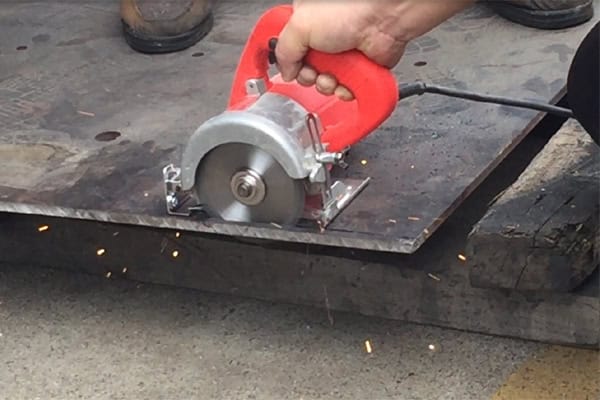
Cutting through wood and metal might seem straightforward, but choosing the right blade makes all the difference. Using the wrong one? It can turn a simple job into a real headache.
Wood Blade vs Metal Blade: What’s the Difference?
The main difference between wood and metal blades is the type of teeth they have and the material they’re designed to cut. Wood blades often have larger, sharper teeth to handle softer material, while metal blades have fine teeth and use stronger materials to withstand cutting through hard, dense metals. The right blade ensures a clean cut and avoids unnecessary wear on your tools.
So, what makes each blade unique? Let’s take a deeper dive into it.
What Kind of Saw Cuts Through Metal?
When it comes to cutting metal, not just any saw will do—you need a tool that’s up for the task.
For cutting through metal, a metal-cutting saw or a chop saw is ideal. These saws are specifically built to handle the strength of metal. Metal-cutting circular saws feature heat-resistant carbide-tipped teeth and lower RPMs, which are crucial for getting a clean cut without wearing down your blade prematurely.

Saws for Metal Cutting: An Overview
The right saw matters because metal is much harder to cut than wood. Chop saws, also known as cut-off saws, use abrasive discs that grind through the material rather than cut it in the traditional sense. This means less strain on the teeth and more efficient metal cutting. Carbide-tipped saw blades1 also come into play when precision is required—these blades are designed to keep heat in check while making sharp cuts.
For those DIYers out there, an angle grinder can also work for small metal-cutting jobs, though it’s not as clean or efficient as a purpose-built metal saw.
| Saw Type | Best Use | Avantajlar |
|---|---|---|
| Doğrama testeresi | Metal Pipes | Fast cuts, easy to use |
| Angle Grinder | Small Projects | Portable, versatile |
| Dairesel testere | Metal Sheets | Precise cuts with appropriate blade |
What is TCT Saw Blade? How is it Useful for Metal Cutting?
You might have heard of TCT blades, but what exactly are they?
TCT (Tungsten Carbide Tipped) saw blades are designed for both metal and wood cutting, thanks to their durable and heat-resistant carbide tips. These blades provide sharp, clean cuts and are popular for cutting metals like aluminum and other non-ferrous metals without overheating.
Diving Deeper: TCT Blades Explained
TCT blades are a sort of jack-of-all-trades in the saw world—capable of cutting through wood, plastics, and metals with ease. The secret lies in the carbide tips, which remain sharp for longer compared to standard steel blades. Carbide is a composite material, combining the hardness of tungsten2 with cobalt for binding. This gives the teeth both strength and durability.
The heat resistance means less deformation when the blade gets hot, which is especially helpful for cutting metals where friction quickly builds up. Plus, the longevity means you won’t have to replace the blade after a few cuts—it’s built to last.
Best Circular Saw Blade for Cutting Wood?
If you’ve got wood to cut, the right blade can make your job a lot easier.
For cutting wood, a general-purpose blade or a blade with larger, alternating teeth (ATB – Alternate Top Bevel) is usually best. The ATB design helps make clean, cross-grain cuts without too much splintering, making it ideal for both hardwoods and softwoods.

Choosing the Perfect Blade for Woodwork
Wood-cutting saw blades are designed with fewer teeth than metal blades, which allows for quicker, smoother cuts. The fewer teeth allow for faster removal of wood shavings3, making it easier to cut through even thicker pieces of wood without burning.
If you’re working on construction or general carpentry, a 24-tooth framing blade will likely do the trick. For finer work, where the finish matters, you’ll want to go with a 60-tooth or even an 80-tooth blade. These higher-tooth-count blades create smooth finishes that require less sanding or cleanup.
| Tooth Count | Best Use |
|---|---|
| 24-Teeth | Rough, fast cuts |
| 40-60 Teeth | General-purpose, clean cuts |
| 80+ Teeth | Fine woodworking |
Can I Use a Metal-Cutting Blade on Wood?
Sometimes we’re tempted to just use what’s on hand. But is it a good idea?
No, it’s not recommended to use a metal-cutting blade on wood. The fine teeth and higher resistance can cause friction that leads to burning, and you won’t get a clean cut. It’s best to use a blade specifically designed for wood to get the desired results.
Why Metal Blades Don’t Work Well on Wood
Using a metal blade for wood cutting is a bit like trying to use a scalpel where you need an axe—it’s simply not suited for the job. Metal-cutting blades have more teeth and are designed to grind through dense materials, but wood is soft and fibrous. The result is that the blade tends to overheat, and the cut becomes rough and jagged. Not to mention, you risk damaging the blade or even the saw itself.
On the flip side, using a wood blade on metal4 is even worse, as it can lead to shattered teeth and safety hazards. Always match the blade to the job, and your tools will thank you!
Çözüm
Choosing the right blade makes all the difference. Wood or metal, the blade you use impacts efficiency, quality, and safety.
-
Unique properties of carbide-tipped blades, such as heat resistance and precision, are critical for metal-cutting tasks. ↩
-
The role tungsten plays in enhancing the strength and lifespan of carbide-tipped saw blades. ↩
-
The role of wood shavings in cutting efficiency and how blade design impacts their removal, ensuring smoother, faster cuts. ↩
-
Offers safety-critical information about the risks of using the wrong blade for metal. ↩